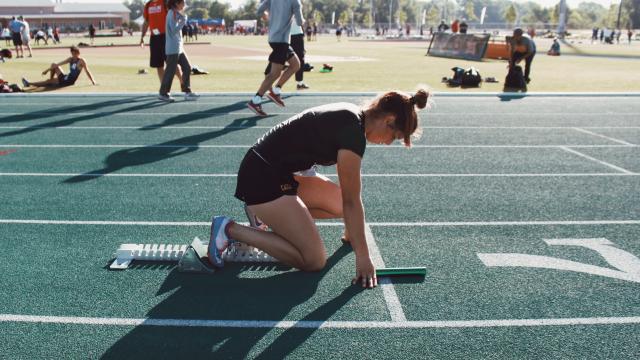If you’re not a runner, but you’d like to be, the classic way to start is with a couch-to-5K program (available in convenient app, podcast, or printable chart form). But we know you’ll have plenty of questions along the way, so here’s what you need to know.
What happens in a couch-to-5k program?
On your first day, you run for one minute. Just one! Then you walk for 90 seconds. Then you run for one minute again. After 20 minutes of this back-and-forth, you’re done running for the day. (The program also recommends five minutes of warmup and cooldown, which can be walking.)
By the end of the program — usually nine weeks, with three workouts per week — you’re able to run for half an hour without stopping. You can graduate by running a 5K race, which will take about 30 to 40 minutes for an average beginner, faster if you were in good shape to start with.
Am I too out-of-shape if I get winded right away?
Whether you feel out of breath is a measure of the intensity of your running. Every runner, even Olympic medalists, has a speed that makes them feel out of breath. And everyone, even you, has a speed that is so slow it feels easy.
Here’s Couch to 5K’s best kept secret: it’s not really about gaining endurance, although that’s a nice benefit. It’s about learning to pace yourself.
By increasing the run times and decreasing the walk breaks in between, you’ll teach yourself to run slower. If you run slow enough, you can cover the entire five kilometers without needing to take a walk break.
What gear do I need to start?
At first, not much. Some shoes that don’t hurt your feet when you run; some clothes that cover your body comfortably. Don’t overthink it.
As you progress, you may want to visit a running store to try on a bunch of different shoes. No matter what the person at the store says, do not buy anything that feels uncomfortable. If they try to steer you to certain shoes based on your foot shape or how you run, make sure to also ask to try on a neutral shoe. (Research suggests neutral shoes are best for most of us.)
If I’m not getting any faster, am I doing it wrong?
No. Whether you’re still on a couch-to-5k plan, or you’ve finished and are trying to run on your own a few days a week, your sessions are training runs, not races. Even elite runners spend most of their time doing easy, boring miles.
Slow runs help you get faster. Want to tell if you’re improving? Run a 5K race (or time yourself on a distance of your choice, say one mile) and then train at an easy pace for a month or two. Try another race or time trial, and then you’ll be able to tell how much you’ve improved. When it’s not race day, just put in the easy miles.
Do I have to rest on the rest days?
Couch-to-5k programs typically ask you to run three days a week. If you’re not used to any exercise at all, or if you find yourself sore or tired after running days, honour those rest days.
But if you’re already active, there’s no problem working in other exercise around those three runs. Don’t add any more running, because your body needs time to get used to the specific stresses of running. (Your tendons, ligaments, and bones will thank you for the gradual buildup.) But feel free to swim, bike, lift weights, or whatever else makes you happy.
What if I miss a run, or a whole week?
Don’t view the 9-week schedule as ironclad. It’s fine to swap a rest day with a workout day, even if it means you’re running two days in a row.
And if you miss a week, or if you finished a week but really struggled with it, just repeat that week. Your body is still getting the benefits of exercise no matter which week you’re on. Some people need a little more time than others.
You may find that partway through the program, you’re ready for more. I did a couch-to-5k type of program when I first started running, and one day I decided to try running as slowly as possible to see if I could skip the walk breaks.
It worked, and I completed the full workout without needing to slow down. From then on, I knew I didn’t need the program anymore; I could just go out for a run and, well, run. You’ll get to that point too, if you just stick with it.

Comments